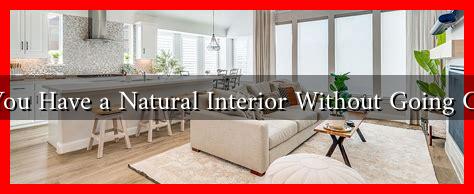-
Table of Contents
Can You Have a Natural Interior Without Going Green?
In recent years, the concept of “going green” has gained significant traction in the world of interior design. However, many people wonder if it’s possible to create a natural interior that feels organic and inviting without strictly adhering to eco-friendly practices. This article explores the nuances of achieving a natural aesthetic while considering the implications of sustainability.
Understanding Natural Interiors
Natural interiors are characterized by their use of organic materials, earthy colors, and a connection to the outdoors. The goal is to create a space that feels warm, inviting, and harmonious with nature. While many associate this style with eco-friendly practices, it is possible to achieve a natural look without necessarily “going green.”
Key Elements of a Natural Interior
To create a natural interior, consider incorporating the following elements:
- Natural Materials: Use materials like wood, stone, and clay that evoke a sense of nature.
- Earthy Color Palette: Opt for colors inspired by nature, such as greens, browns, and soft neutrals.
- Textural Variety: Incorporate different textures through fabrics, rugs, and wall finishes to create depth.
- Natural Light: Maximize natural light through large windows or skylights to enhance the connection with the outdoors.
- Indoor Plants: While not strictly “going green,” adding plants can enhance air quality and bring life to your space.
Examples of Natural Interiors Without Going Green
Many designers have successfully created natural interiors that do not strictly adhere to eco-friendly principles. Here are a few examples:
- Rustic Farmhouse: A rustic farmhouse design can feature reclaimed wood and vintage furnishings without necessarily being eco-certified. The charm lies in the history of the materials rather than their sustainability.
- Modern Minimalism: A minimalist approach can utilize synthetic materials that mimic natural textures, such as faux leather or engineered wood, while still achieving a clean, natural look.
- Industrial Chic: This style often incorporates metal and concrete, which are not traditionally considered “green,” but can create a raw, natural aesthetic when paired with warm wood and soft textiles.
Case Studies: Successful Natural Interiors
Several case studies illustrate how designers have achieved natural interiors without a strict focus on sustainability:
- The High Line Hotel, New York: This hotel features a blend of vintage and modern elements, using materials like reclaimed wood and exposed brick. While not all materials are eco-friendly, the overall aesthetic feels natural and inviting.
- Casa de la Flora, Thailand: This resort uses concrete and glass to create a modern design that feels connected to its natural surroundings. The focus is on the experience rather than the sustainability of materials.
Statistics and Trends
According to a survey by the American Society of Interior Designers (ASID), 70% of consumers are interested in natural materials in their homes, regardless of their environmental impact. This trend indicates a growing appreciation for aesthetics over strict adherence to eco-friendly practices.
Conclusion: Finding Balance in Design
In conclusion, it is entirely possible to create a natural interior without strictly going green. By focusing on natural materials, earthy colors, and a connection to the outdoors, homeowners can achieve a warm and inviting space. While sustainability is an important consideration, the aesthetic appeal of a natural interior can be achieved through various means, including the use of synthetic materials that mimic natural textures.
Ultimately, the key is to find a balance that resonates with your personal style and values. Whether you choose to incorporate eco-friendly practices or not, a natural interior can enhance your living space and create a sense of tranquility and connection to nature.
For more insights on interior design trends, visit ASID.



